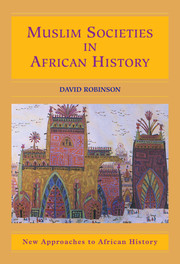Book contents
- Frontmatter
- Acknowledgments
- Contents
- LIST OF MAPS AND FIGURES
- INTRODUCTION
- PART I The Historical and Institutional Background
- PART II General Themes
- 3 The Islamization of Africa
- 4 The Africanization of Islam
- 5 Muslim Identity and the Slave Trades
- 6 Western Views of Africa and Islam
- PART III Case Studies
- CONCLUSION
- GLOSSARY
- INDEX
6 - Western Views of Africa and Islam
Published online by Cambridge University Press: 05 June 2012
- Frontmatter
- Acknowledgments
- Contents
- LIST OF MAPS AND FIGURES
- INTRODUCTION
- PART I The Historical and Institutional Background
- PART II General Themes
- 3 The Islamization of Africa
- 4 The Africanization of Islam
- 5 Muslim Identity and the Slave Trades
- 6 Western Views of Africa and Islam
- PART III Case Studies
- CONCLUSION
- GLOSSARY
- INDEX
Summary
The “West” has been the dominant force in world history in the past two centuries, if not the past five. In the form of the Western European countries and North America, it has imposed on the rest of the world a calendar; a way of dividing the day; a system of mapping; an international monetary system; many agricultural, industrial, and electronic norms; a construction of education from kindergarten to professional studies; and other frameworks that we usually take for granted. These are simply the way “things” work. Along with these structures come some very important definitions and attitudes about Africa and Islam that a book such as this one cannot ignore.
The Ancient Heritage and Africa
To uncover the layers of these attitudes, we need to go back to the “beginning,” which I take to be the Ptolemaic conception of the world. Ptolemy was a Greek scholar who lived in Alexandria, Egypt, in the second century c.e.; he put together much ancient wisdom and lore about the world. This view, mentioned in the previous chapter, took the Mediterranean societies of Ancient Egypt, Greece, and Rome and other areas as the “norm” – centers of civilization in a temperate climate, permitting the development of agriculture and urban life. In this framework of zones or “climes” the “Mediterraneans” occupied the middle positions (3 and 4) out of 7. The first clime was in the far south, amid intense heat, and was essentially uninhabitable.
- Type
- Chapter
- Information
- Muslim Societies in African History , pp. 74 - 88Publisher: Cambridge University PressPrint publication year: 2004



